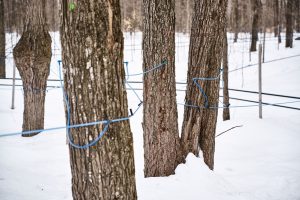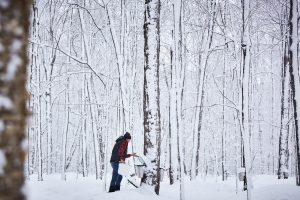Is Maple Syrup Sustainable?
THE SUSTAINABILITY CREDENTIALS OF MAPLE SYRUP
Sustainability is a hot topic in the food industry, with consumers and manufacturers looking to reduce their environmental footprint amid a worsening climate crisis.
This is especially true with sugar, a crop which has had an unparalleled impact on the environment by fuelling deforestation and spreading pollution through fertilisers.
While the sugar industry seeks to improve its poor environmental record, many consumers are now switching to alternative sweeteners like maple syrup.
But is maple syrup sustainable? Find out below.
How maple syrup is produced sustainably
To find out whether maple syrup is sustainable, it’s important to first answer the question: “How is maple syrup made?”.
The process begins in spring, when the alternating freeze-thaw cycles of day and night create pressure in the maple trees that yield maple syrup.
This pressure pushes the sugary sap used to make maple syrup up from the roots of the tree and out towards the trunk and branches.
From this position, the sap can be harvested by drilling small holes in the tree and attaching tubes to collect the liquid.
Once transported to the sugar shack, the sap is boiled to reduce the water content, eventually forming maple syrup.
Throughout the production process – which has remained largely the same for hundreds of years – no fertilisers are used, and no harm is done to the surrounding environment.

The ecological benefits of maple syrup
In Quebec – the Canadian province responsible for producing 72% of the world’s maple syrup – there are more than 34 million maple trees used to produce maple syrup.
These trees cover huge swathes of Quebec and several other Canadian provinces, forming large forest habitats that are incredibly rich in biodiversity.
It’s estimated that Canadian maple forests are home to 17 endangered wildlife species and 40 threatened plants.
Key to the ecological balance of the forest, maple trees provide shelter and sustenance for some of these species.
Moose, deer, hares and squirrels are all known to feed on the buds, seeds and branches of maple trees, while honeybees collect nectar from their leaves at the start of spring.
Songbirds, screech owls and woodpeckers also use the trees for shelter, as do more than 300 species of moth and butterfly.
As well as providing food and shelter, the maple trees also produce vital oxygen for animals and other plants. Put simply, the forest ecosystem wouldn’t be the same without them!
The environmental benefits of maple syrup
Maple forests not only support rich biodiversity but also play a crucial role in fighting climate change by serving as carbon sinks.
As the trees grow, they capture carbon dioxide from the atmosphere and store it in their trunks and roots as well as the surrounding soil.
Some of the carbon dioxide is converted into energy, releasing oxygen as a by-product and improving the air quality of the forest.
It’s estimated that the 34 million trees used in Quebec capture the carbon produced by burning 97 million gallons of petrol every year – that’s equivalent to 220,000 cars!
So while the processing of maple syrup does generate some emissions, these are greatly outweighed by the carbon stored in maple trees.
In fact, it’s estimated the maple forests of Quebec capture and store eight times the amount of carbon emitted during the production of maple syrup.

How maple forests are sustainably managed
Deforestation remains a major concern worldwide, with logging activities weakening the ability of the planet to cope with climate change by removing its carbon sinks.
To protect the ecological and environmental value of its maple forests, Quebec has taken measures to ban commercial logging in all areas used for producing maple syrup.
Additionally, maple syrup farmers are required to follow a set of guidelines that align with the province’s strategy for sustainable forest management.
As part of these guidelines, conservative tapping methods are implemented to allow the trees sufficient time to recover.
Younger trees with a diameter at breast height of 12 inches are tapped only once, while older trees can sustain multiple taps without being permanently damaged.
With these sustainable management practices in place, the same maple tree can be used to make maple syrup for more than 100 years!
So, is maple syrup sustainable?
Pure maple syrup, derived naturally without the use of fertilisers, provides a sustainable alternative to processed sweeteners like table sugar.
Moreover, the forests where maple sap is harvested act as carbon sinks, drawing in carbon dioxide from the atmosphere and converting it into oxygen.
The amount of carbon captured by these trees greatly outweighs the emissions generated during production, making maple syrup a sustainable sweetener.
Curious about using maple syrup in your cooking and baking? Be sure to explore our collection of maple syrup recipes for inspiration!
Hundreds of Delicious Recipes
Maple is a special addition to any recipe, from appetiser to dessert. Find one that’s perfect for you!
